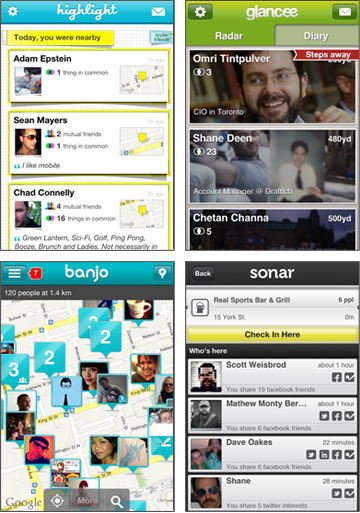 I’d insert the usual obligatory stalking comment here, but you’re already thinking it.
I’d insert the usual obligatory stalking comment here, but you’re already thinking it.
The ability to share your location through your smartphone to your friends and social networks is not a new concept. In 2009, Foursquare launched and asked its users to check-in to a location to unlock a deal or reward, or to discover a tip left by a friend. Gowalla did much the same thing, but was purchased by Facebook to help enhance its underdeveloped ‘Places’ check-in feature. Almost every app on your smartphone (including your camera) has the ability to create and share information about your location, that is, unless you’ve decided to turn it off.
However, stopping to ‘check-in’ at a venue is not necessarily a natural behavior and interrupts the experience. Despite this, more that 3 million Foursquare users check-in everyday. Their motivations run the gamut from unlocking deals to earning badges to the simple fact that they like sharing what they’re doing with friends.
A new wave of smartphone apps is doing away with the check-in completely and will share your present location, even alerting people within your network when you are close by. Google Latitude, which has recently been revamped, was one of the first examples of this type of app, sharing your exact or general location on Google Maps to your contacts. Apple included the ‘Find My Friends’ app with iOS 5, allowing iPhone, iPod and iPad users to see their friends locations, as long as their friends are using the app on their iPhone, iPod or iPad.
Apps that take advantage of your smartphone’s ability to share location information while the app runs in the background have been gaining attention over the past few months. These apps have been referred to as persistent, ambient or always-on location apps. They also have the ability to leverage your existing social networks such as Facebook, Twitter and Foursquare. But they can suck the life out of your already strained battery, using up power every time they report your location.
Four examples of these ambient location apps are:
Highlight
Of these four examples, Highlight is the app that seems to be getting the most attention. The app alerts you (if you have push notifications turned on) when another Highlight user, a Facebook friend—or just someone that the app determines you share common interests with—is close by. These common interests are determined by things you have ‘Liked’ using your Facebook profile. Should you want to say hello, you can message the other person directly through the app.
Glancee
Glancee works in much the same manner as Highlight, showing you people that you know or have common interests with that are nearby from ‘Steps Away’ (which sounds super creepy) to ‘4 miles away’. The app computes how often a user is moving around and slows down the frequency of notifications if you stay in the same place for a period of time, such as work or home. Glancee has a superior interface to Highlight, with the home screen divided into Radar (showing people nearby) and Diary (showing a record of profiles you have viewed or interacted with). Once you open a user’s profile you can chat, add to contacts, see the names of people and things you have in common.
Ban.jo
The Ban.jo app is not new, having been released back in June of 2011. The app pulls in data from dozens of sources including geotagged tweets, uploaded photos and other content shared on social networks that contains location data. The app will alert you when a Facebook or Twitter friend is nearby, or you can view a map of everyone’s location around you or a mosaic of their profile pictures. From these screens you can tap to see their profile, recent shared content, send a message or follow them on Twitter.
Sonar
Sonar is another app that has been around since the spring of 2011. The app uses Foursquare check-ins to determine where the hot locations are around you. When you choose a location it shows you a list of people who have recently checked in there and whether you have common connections on Foursquare, Facebook or Twitter.
It’s shocking to see the amount of data you can access about people around you using these simple apps. On one hand these apps present a great opportunity for people to meet others with shared interests, but on the other hand there are the real dangers associated with sharing ‘too much.’
Thanks to these apps you don’t have to tell me where you are anymore, I already know.
Do you have a favourite one? Or do they all freak you out too much to use?
I am currently using all of them… getting pings every 10 minutes or so while I was downtown as people enter my area… I, myself have no concern about them. However, I do feel that people do not understand how much data they ate sharing involuntarily within their normal day… tweet a few times, comment or update a FB status, Instagram a photo… it’s done, it’s shared forever complete with GPS data. Is this good, bad or whatever?
I can agree, as an early adopter and professional in the space, I play with everything and pay for it with my privacy. I am thinking these new location aware apps will be popular for a while to come, but I tend to agree with you.nnIn a smaller market, they aren’t as useful. In a crowded market, like a conference, I would think they would be annoying from too many notifications.nnI wrote about them on my blog recently: http://www.davemadethat.com/2012/03/06/location-awareness-is-next/nnIt will be interesting to see how they progress and what the adoption will be like.